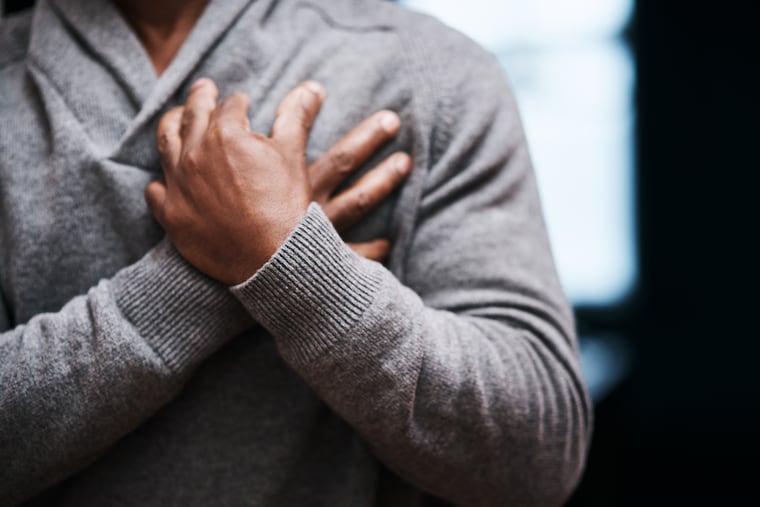Medical mystery: Were the man’s fever, chest tightness symptoms of COVID-19?
He assessed his symptoms: fever, chest pain and tightness, and weak legs. Immediately, he recognized some of his symptoms were consistent with those associated with COVID-19.

In late March, Kanti Somani woke up in the middle of the night with severe chest pain.
“It felt like a ton of bricks on my chest,” he recalled.
The 57-year-old left his bedroom and walked downstairs. He assessed his symptoms: fever, chest pain and tightness, and weak legs. Immediately, he recognized that some of his symptoms were consistent with those associated with COVID-19 — and very similar to a patient’s story he had heard on the news the night before. Convinced that he had developed the disease caused by coronavirus, Somani decided to self-quarantine to protect his wife and kids.
Over the next couple of days, the tightness in his chest subsided but he still felt short of breath. His temperature spiked every 16 to 18 hours. Every night, he found it was more difficult to fall asleep and remain sleeping.
“I almost had to sleep sitting up,” Somani said. “When I did sleep, adrenaline would wake me up because I wasn’t getting enough oxygen.”
About a week after he first experienced symptoms, Somani and his wife agreed that they would go to a drive-through testing site early the next morning to determine whether he was positive for COVID-19. However, hours later, Somani told his wife he wanted to go to the hospital to be evaluated. Upon his arrival, Somani listed his symptoms and said he believed he had COVID-19.
Somani underwent a number of tests, including a COVID-19 test, which came back negative. With COVID-19 ruled out, what was causing his symptoms?
» READ MORE: What are the first symptoms of the coronavirus?
Solution
An electrocardiogram (a test that measures the electrical activity of the heartbeat) and blood tests suggested a recent heart attack. In fact, his severe, sudden-onset chest pain the week before was likely the heart attack itself. The progressive shortness of breath that followed, and which led him eventually to seek care, suggested that the heart attack had damaged his heart in such a way that it was not effectively pumping blood.
Somani also had several signs of having an infection. He continued to have fevers, and his white blood count was elevated on blood tests. Was it possible that he had a heart attack and an infection? Were these two diagnoses related?
An echocardiogram, an ultrasound of the heart, revealed that the bottom part of the heart muscle was not squeezing well – confirming that damage had been done. When we looked closely at the mitral valve, we noticed regurgitation, which occurs when blood leaks backward into the left atrium. Some heart attacks, especially if not treated immediately, can cause damage to the mitral valve, leading to shortness of breath and heart failure.
Over the next 24 hours, Somani became increasingly sick. His oxygen levels started to worsen and his blood pressure dropped. He was transferred to the cardiac intensive-care unit and we performed a transesophageal echocardiogram. This test confirmed what we had expected: The muscle that attaches the mitral valve to the myocardium had ruptured, causing his mitral valve to flail. A cardiac catheterization confirmed that his right coronary artery was 100% blocked – explaining why his heart muscle was weakened and his mitral valve was damaged.
Somani did not show any further signs of infection. His fever was likely an inflammatory response to his heart attack and his repeat COVID-19 testing was again negative.
» READ MORE: Tree-pollen season gets an early start: Will people mistake sneezing, coughing for coronavirus symptoms?
As his condition deteriorated, our team decided to proceed with emergent surgery. First, we had to stabilize him on the heart lung machine — called extracorporeal membrane oxygenation (ECMO) — to support his blood pressure and provide time for his lung function to improve. This provided a window to safely replace his mitral valve. After a successful surgery, Somani recovered and was safely discharged home.
But his case highlights a larger issue amid the COVID-19 outbreak: Some patients who are experiencing severe symptoms, such as chest pain or shortness of breath, assume that they are infected with the disease and self-quarantine rather than seek care. In patients with a heart attack, it is critically important to make the diagnosis and open up the blockage to restore blood to the heart as quickly as possible. This is why it is so important for people to call 911 if they think they are having a heart attack. For non-emergent cases, patients can also use telemedicine services to connect with their physicians and discuss any symptoms they may be experiencing.
» READ MORE: Fearing coronavirus at hospitals, patients with heart attacks or strokes may be staying away, doctors say
A delayed diagnosis can have severe, life-threatening consequences. Fortunately, we were able to make the diagnosis before it was too late.
“I knew my history — I knew it from day one,” Somani said. “My father died of a heart attack at age 45. I’m 57 now, and I’ve never taken a day for granted. But with everything going on, I had tunnel vision. I thought I had COVID-19 — everything else was irrelevant.”
Pavan Atluri is a cardiac surgeon and director of the Minimally Invasive and Robotic Cardiac Surgery Program at Penn Medicine, and Jennifer Lewey is a cardiologist and director of Penn Women’s Cardiovascular Health Program.